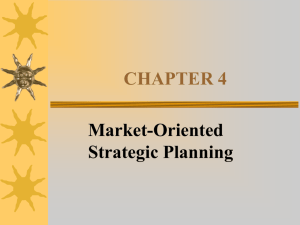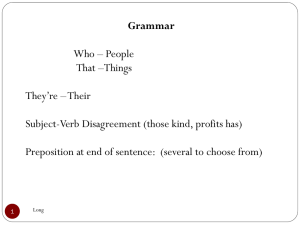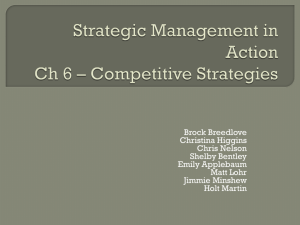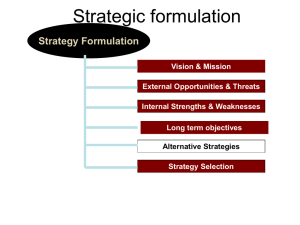Strategy Implementation
advertisement
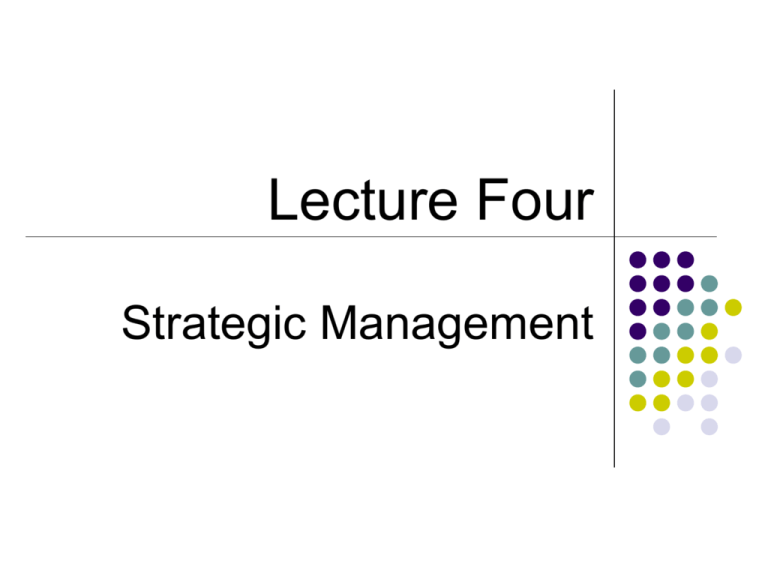
Lecture Four Strategic Management The Strategic-Management Process Step 1:Establish The Mission & The Vision A good mission statement expresses the organization’s purpose or reason for being A good vision statement describes the longterm goal of what the organization wants to become Mission Statement Does your company’s mission statement answer these questions? Who are our customers? What are our major products or services? What is our basic technology? What is our commitment to economic objectives? What are our basic beliefs and values? What are our major strengths and competitive advantages? What are our public responsibilities? What is our attitude toward our employees? Vision Statement Does your company’s vision statement answer “yes” to these questions? Is it appropriate for organization and for the times? Does it set standards of excellence and reflect high ideals? Does it clarify purpose and direction? Does it inspire enthusiasm and encourage commitment? Is it well articulated and easily understood? Is it ambitious? Step 2:Establish The Grand Strategy grand strategy explains how the organization’s mission is to be accomplished The Three common grand strategies are growth (involves expansion of sales revenue, market share, number of employees, or number of customers served), stability (involves little or no significant change), and defensive (involves reduction in the organization’s efforts) Establishing The Grand Strategy SWOT Analysis Forecasting: Predicting the Future After completing the SWOT analysis, managers need to make forecasts (visions or projections of the future) There are two types of forecasts: A hypothetical extension of a past series of events into the future is a trend analysis The creation of alternative hypothetical but equally likely future conditions is contingency planning or scenario planning Boston Consulting Group Matrix (BCG Matrix) Boston Consulting Group Matrix (BCG Matrix) Stars have a high share of a high-growth market. They typically need large amount of cash to support their rapid and significant growth. They also generate large amount of cash for the organization and usually areas in which management can make additional investments and earn attractive returns. Cash Cows have a large share of a market that is growing only slightly. Naturally, these units provide organization with large amounts of cash. Since the market is not growing significantly, this cash is generally used to meet financial demands of the organization in other areas, such as in the expansion of a “star” units. Boston Consulting Group Matrix (BCG Matrix) Question marks have a small share of a high-growth market. These units are called question marks because it’s uncertain whether management should invest more cash in them to get a large share of the market, or whether management should de-emphasize or eliminate them because such an investment would be ineffective. Naturally, through further investment, management attempts to turn “question marks” into “stars”. Dogs have a relatively small share of a low-growth market. These units may barely support themselves, or they may even drain cash resources that other units have generated. BCG Matrix Sample Organizational Strategies Growth— “Stars” & “Question marks”(which hold the potential of being “Stars”) Stability— “Cash Cow” Retrenchment— “Cash Cow” & “Stars”(which begin to lose market share) Divestiture— “Dogs” & “Question marks”(which have failed to increase market share but still require a big amount of cash) Step 3:Formulate Strategic Plans The process of choosing among different strategies and altering them to best fit the organization’s needs is strategy formulation The strategy formulation process can be completed using techniques like Porter’s competitive forces and strategies, and product life cycles Porter’s Five Competitive Forces Porter’s Five Competitive Forces include: 1. The threat of new entrants New competitors can shake-up an industry virtually overnight 2. The bargaining power of suppliers Companies that rely on a single supplier are vulnerable Porter’s Five Competitive Forces 3. The bargaining power of buyers Major customers, and customers that shop around can negotiate better prices 4. The threat of substitute products or services When there are substitute products or services available, firms have less power 5. Rivalry among competitors Intense rivalry is a threat to companies Porter’s four competitive strategies or generic strategies 1. The cost leadership strategy - involves trying to keep costs and prices below those of competitors and targeting a wide market Examples of companies with this strategy include Bic, Home Depot, and Dell 2. The differentiation strategy - offer products or services that are of unique and superior value compared to those of competitors, and sell to a wide market Examples of companies using a differentiation strategy include Nordstrom and Ritz-Carlton Hotels Porter’s four competitive strategies or generic strategies 3. The cost-focus strategy - keep costs and prices below those of competitors and target a narrow market Examples of companies with a cost-focus strategy include regional gas stations 4. The focused-differentiation strategy - offer products or services that are of unique and superior value compared to those of competitors, and sell to a narrow market Examples of companies with this strategy include Ferrari and Lamborghini Product Life Cycle Introduction stage, the product is introduced to the marketplace Example? Strategy: differentiation or a focus (cost-focus or differentiation) strategy Product Life Cycle Growth stage, customer demand increases, sales grow, and competitors may enter the market Example? Strategy: differentiation or a focus (cost-focus or differentiation) strategy Product Life Cycle Maturity stage, the product starts to fall out of favor and sales and profits drop Example? Strategy: cost leadership or a focus (cost-focus or differentiation) strategy Product Life Cycle Decline stage, the product falls out of favor and is withdrawn from the marketplace Example? Diversification and Synergy A company that makes and sells only one product in its market follows a single-product strategy This strategy has both benefits (the firm can focus on just one product) and risks (the firm is vulnerable to competitors) Diversification and Synergy The diversification strategy involves operating several businesses in order to spread the risk There are two kinds of diversification: unrelated (operating several businesses that are not related to each other) related (operating several businesses that are related) Unrelated Diversification General Electric Lighting products Plastics Broadcasting Financial Services Diversification and Synergy 1. 2. 3. There are three advantages to related diversification: reduced risk because the firm sells more than one product management efficiencies because administration is spread over several businesses synergy because the economic value of separate, related companies operating under one roof is greater than the companies are worth separately Competitive Intelligence When companies gain information about their competitors so that they can anticipate their moves and react appropriately, the companies are practicing competitive intelligence Companies can collect information on their competitors through public prints and advertising, through investor information, and through informal sources Step 4:Carry Out The Strategic Plan Strategy implementation involves putting strategic plans into effect Managers need to ensure that the right people and control systems are in place to execute the plans Strategy Implementation The execution stage of strategy involves getting things done Execution is a central part of strategy that consists of using questioning, analysis, and follow-through to mesh strategy with reality, align people with goals, and achieve promised results Strategy Implementation There are three building blocks underlying effective execution: 1. Develop seven essential leader behaviors know your people and your business insist on realism set clear goals and priorities follow through reward the doers expand people’s capabilities know yourself Strategy Implementation 2. Create a framework for cultural change Leaders must understand how to change the behavior and beliefs of people who are directly linked to bottom-line results To do this, tell people what results are necessary, how to get the results, and what the reward is for achieving the results 3. Select & evaluate people Leaders should personally select the right people to get the job done Strategy Implementation The three building blocks are the foundation for the three core processes of execution The First Core Process: People Effective leaders evaluate talent using specific milestones, develop future leaders, and deal with non-performers—they get the people part right The Second Core Process: Strategy A good strategic plan considers the “how” of execution Strategy Implementation The Third Core Process: Operations Strategy defines where the organization wants to go, the people process assigns responsibility for getting there, and the operating plan shows how to get there The success of strategy execution depends on how well leaders manage the three processes of strategy, people, and operations Step 5:Maintain Strategic Control: The Feedback Loop Monitoring the execution of strategy and making necessary adjustments is strategic control To keep strategic plans on track, managers need to encourage people, keep planning simple, stay focused, and keep moving
